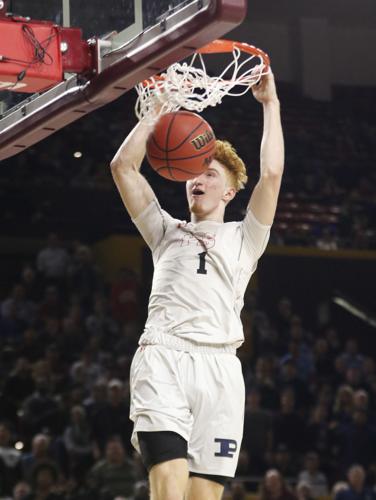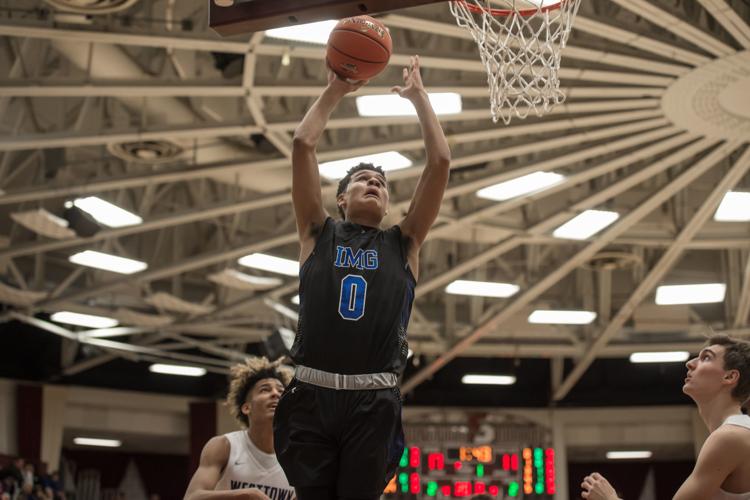Throughout one of their worst seasons in 35 years, the Arizona Wildcats always had hope in their back pocket.
Five highly rated players signed or committed to the Wildcats last fall, including two guards who will appear in Wednesday’s McDonald’s All-American Game: Nico Mannion and Josh Green.
The five-star backcourt pair, who became close friends while playing for the West Coast Elite club program, were also both named Monday to the World Team of the prestigious Hoop Summit game on April 12.
Born in Italy but having lived in the United States since age two, Mannion already proved himself while playing for the Italian national team in a World Cup qualifier last summer, while Green might play for Australia in the World Cup late this summer.
But is it too much to expect Mannion and Green to wrap up all that, enroll at the UA and begin rescuing the Wildcats immediately next season?
Maybe not.
“It’s a lot of pressure considering the expectations on both of them, but they’re entering college very highly touted and accomplished,” 24/7 Sports analyst Josh Gershon says. “Both of them really had successful high school careers and they both entered high school as big names. They were both playing up at an early age and they’ve both really progressed.”
While there have been exceptions, Arizona basketball history suggests loading up with McDonald’s players often leads quickly to success, as the Wildcats experienced in 2013-14 and 2014-15, when burger boys such as Aaron Gordon, Rondae Hollis-Jefferson and Stanley Johnson played for powerful UA teams.
Here’s a look at how all of the McDonald’s All-Americans to play for Sean Miller affected the Wildcats:
2012-13
Who: F Brandon Ashley (freshman), F Grant Jerrett (freshman)
How they arrived: Jerrett committed as a high school junior during Miller’s second season of 2010-11, even before the Wildcats reached that season’s Elite Eight with Derrick Williams.
Ashley committed to Arizona as a highly rated star for Oakland De La Salle High School and the Oakland Soldiers travel team.
Where they fit: After starting the 6-foot-7 Jesse Perry at center during the 2011-12 season, the Wildcats badly needed the size and skills of Ashley, Jerrett and a third freshman big man, Kaleb Tarczewski (who was not eligible for the McDonald’s game because he was a fifth-year senior).
Still, both played supplemental, not standout, roles as freshmen for a team led by seniors Mark Lyons and Solomon Hill. Ashley started at power forward for 21 of 35 games, averaging 7.5 points a game. Jerrett came off the bench in all but two games while averaging only 17.8 minutes.
How they finished: The Wildcats went 27-8 and in a second-place tie in the Pac-10 at 12-6. They reached the NCAA Sweet 16, when Jerrett blamed himself for missing a key defensive switch that allowed Ohio State’s LaQuinton Ross to hit a game-winning 3-pointer in the Buckeyes’ 73-70 win.
After the season, with his role unlikely to increase because of the arrival of five-star forward Aaron Gordon, Jerrett opted to declare for the 2013 NBA Draft. He was taken with the No. 40 pick, but has played only eight games in the NBA.
2013-14
Who: F Brandon Ashley (sophomore), F Aaron Gordon (freshman), F Rondae Hollis-Jefferson (freshman)
How they arrived: Then known just as Rondae Jefferson, the tough and rangy forward from Chester, Pennsylvania, committed during an in-home visit in September of 2012. Gordon capped a long, high-profile recruitment by announcing his choice during the 2013 McDonald’s pregame media day. Gesturing toward Jefferson in the crowd of media and players, Gordon said, “Let’s go, Rondae!”
Where they fit: They did go places. With Hollis-Jefferson bringing defense, energy and athleticism in a sixth-man role, and Gordon averaging 12.4 points and 8.4 rebounds, Arizona had arguably its most successful season of the Miller era. Ashley was the team’s third-leading scorer, averaging 11.5 points a game, but suffered a season-ending foot injury at California midway through Pac-12 play.
How they finished: Had Ashley been healthy for the postseason, the Wildcats might have reached their first Final Four since 2001. For much of the season, they looked like a team that could do it, getting off to the best start in school history (21-0), losing only twice in Pac-12 play. The UA still received a No. 1 NCAA Tournament seed and reached the Elite Eight before losing to No. 2 seed Wisconsin.
Gordon left after the season to become the No. 4 pick in the NBA Draft.
2014-15
Who: F Brandon Ashley (junior), Rondae Hollis-Jefferson (sophomore), Stanley Johnson (freshman)
How he arrived: Before ESPNU cameras in November 2013, Johnson wore a tie as he announced his commitment by holding up a pair of Jordan 2 White Cement shoes that were custom-decorated with red, blue and the UA logo. “I could go on forever about why I chose Arizona,” Johnson said.
Where they fit: The three McDonald’s alums were the top three scorers on a team that won 34 games and earned a No. 2 NCAA Tournament seed. Johnson won the Maui Invitational’s MVP award and became the Pac-12 Player of the Year while leading the Wildcats in scoring (13.8). Ashley averaged 12.2 points while Hollis-Jefferson was a first-team all-conference pick.
How they finished: The Wildcats reached the Elite Eight again, but Ashley inadvertently poked Johnson in the eye early in the second half, and Johnson wasn’t the same upon returning. He had six points and two rebounds, while the UA lost 85-78 to Wisconsin. “If I could’ve got a new eyeball, I’d have got a new eyeball,” Johnson said. “I couldn’t.”
All three McDonald’s players became early NBA Draft entrants after the season, but Ashley was not taken. Johnson went eighth and Hollis-Jefferson 23rd.
2015-16
Who: G Allonzo Trier (freshman)
How he arrived: Two months after playing on the 2014 USA Basketball U18 team, for which Miller was an assistant coach, Trier committed to the Wildcats, who had parted ways with former commit Tyler Dorsey earlierr.
Where he fit: Trier started 21 of 26 games, missing a month during the Pac-12 season when he broke a hand at USC, playing alongside senior Gabe York and junior Kadeem Allen in the backcourt. Senior forward Ryan Anderson led the Wildcats in scoring (15.3) and rebounding (10.1).
How they finished: The Wildcats went 25-9 overall, finishing fourth in the Pac-12 with a record of 12-6. They lost four of their final seven games, including an upset loss to Wichita State in the first round of the NCAA Tournament.
2016-17
Who: G Allonzo Trier (sophomore), G Kobi Simmons (freshman)
How he arrived: Simmons announced on ESPN in Jan. 2016 that he would play for the Wildcats, citing a strong relationship with Miller and former assistant coach Book Richardson.
Where they fit: After suffering an injury in an offseason car crash, Trier said he was given a performance-enhancing drug (later revealed to be Ostarine) to help recover and tested positive for PED use in the preseason. He was suspended for 19 games, then returned to become UA’s leading scorer (17.2 points) over freshman Lauri Markkanen (15.2 points).
Simmons spent a head-scratching season with the Wildcats. He led the UA to a season-opening win over Michigan State with 18 points, started 17 straight games in midseason, then gradually fell out of the rotation after Trier returned in late January.
How they finished: Arizona went 32-5, tying Oregon at 16-2 for the Pac-12 title but beating the Ducks in the Pac-12 Tournament behind Trier’s 23 points. However, the Wildcats were upset by Xavier in the Sweet 16.
Simmons declared for the NBA Draft along with Markkanen after the season, but was not selected. He signed a two-way contract with Memphis and has played 32 games in the NBA. Markkanen went No. 7 overall.
2017-18
Who: G Allonzo Trier (junior), C Deandre Ayton (freshman)
How he arrived: Long considered a Kansas lean, Ayton went on ESPN’s “SportsCenter” in September 2016 to announce he would play for Arizona, citing relationships with Miller and former associate head coach Joe Pasternack.
How they fit: Ayton and Trier were a dominant inside-outside punch for the Wildcats all season, with Ayton earning Pac-12 Player of the Year honors while averaging 20.1 points and 11.6 rebounds. Trier was the Wildcats’ second-leading scorer (18.1), but missed two games for another positive PED test before he successfully appealed.
How they finished: The Wildcats lost all three games at the Battle 4 Atlantis in November and never fully lived up to their preseason hype. The UA went 27-8, won the Pac-12 at 14-4 and was bounced in a first-round NCAA Tournament upset loss to Buffalo.
Both Ayton and Trier left after the season for the NBA Draft, along with Rawle Alkins, though neither Trier nor Alkins were drafted. Ayton went No. 1 overall.
2018-19
Who: C Chase Jeter (junior)
How he arrived: Jeter transferred in 2017 after two years of playing a limited role at Duke, then sat out the 2017-18 season.
Where he fit: Jeter stepped right into the Wildcats’ top frontcourt role and served as co-captain, though he was limited by back and knee injuries . He led the Wildcats in rebounding (6.6) and was their third-leading scorer (10.9).
How they finished: Arizona lost seven straight games and 10 of its final 13 to finish 17-15 overall.





